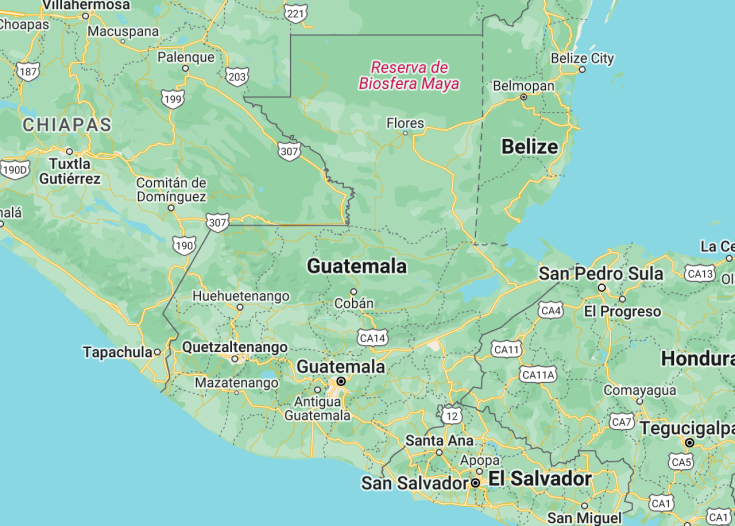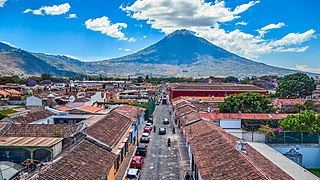Guatemala is a captivating destination that offers a diverse range of natural beauty and cultural experiences. From its stunning landscapes of volcanic peaks, crystal clear lakes, and lush rainforests to its rich Mayan heritage and vibrant markets, Guatemala has something to offer every traveler. Explore the ancient ruins of Tikal, visit the colonial city of Antigua, or immerse yourself in the indigenous cultures of Lake Atitlán. With its warm climate, friendly locals, and affordable prices, Guatemala is the perfect destination for adventurers and cultural enthusiasts alike.
For a unique culinary experience, try the traditional Guatemalan dish called “pepian”. It’s a flavorful meat stew made with roasted vegetables and spices.
Discover the beauty of Semuc Champey and its natural limestone pools. Take a dip in the turquoise water surrounded by lush jungle and cascading waterfalls.
Guatemala: A Central American Gem
| Capital | Guatemala City |
| Time in Guatemala | GMT-6 |
| Language spoken | Spanish |
| Population | 16.6 million (World Bank, 2021) |
| Religion | Roman Catholic (47%), Protestant (40%), Indigenous (10%), Other (3%) |
| Currency | Guatemalan Quetzal (GTQ) |
| Airports | La Aurora International Airport Mundo Maya International Airport Quetzaltenango Airport Puerto Barrios Airport |
Guatemala, often referred to as the “Land of Eternal Spring”, stands as a testament to both natural beauty and historical profundity. Tucked within Central America, it is bordered by the Pacific Ocean, and countries such as Mexico, Belize, Honduras, and El Salvador. The heart of the Mayan civilization, which flourished here for centuries, has left behind an indelible mark on its landscape, with majestic ruins telling tales of an era long gone. The Spanish conquest in the 16th century brought another layer to its already rich tapestry, intertwining colonial architecture with indigenous traditions. Over time, Guatemala has faced its fair share of political strife and revolutions, yet it remains resilient, drawing strength from its legacy and culture. Today, it serves as a beacon for those who seek to uncover the mysteries of ancient civilizations, while also immersing themselves in the vibrant colors, tastes, and sounds of contemporary Latin American life.
Where is Guatemala located?
Guatemala is nestled in Central America, bordered by the Pacific Ocean to the west, Mexico to the north and west, Belize to the northeast, Honduras to the east, and El Salvador to the southeast.
What is Guatemala famous for?
Guatemala is renowned for its rich Mayan heritage, evident in its archaeological sites, its vibrant markets showcasing colorful textiles, and the picturesque colonial city of Antigua, a UNESCO World Heritage site.
History
Pre-Columbian Era (Up to 1492)
Long before the arrival of European explorers, Guatemala was the heartland of the ancient Mayan civilization. Flourishing from 2000 BCE to 900 CE, the Mayans built majestic cities like Tikal, Uaxactun, and Quirigua. They excelled in architecture, astronomy, and art, leaving behind temples, pyramids, and stelae that testify to their sophisticated culture. Despite their advancements, the Mayan city-states witnessed a decline around the 9th century, leading to the abandonment of major centers.
Spanish Conquest (1492-1821)
The arrival of Christopher Columbus in the Americas in 1492 marked the beginning of European influence in the region. By 1523, Spanish conquistadors, led by Pedro de Alvarado, began their conquest of Guatemala. The indigenous population, especially the K’iche’ Maya, resisted fiercely but ultimately succumbed to Spanish weaponry and diseases. Antigua Guatemala became the capital of the Captaincy General of Guatemala, spanning several Central American states. Over the next three centuries, the Spaniards imposed their culture, religion, and governance, assimilating the Mayan and local traditions.
Independence to the Liberal Reform (1821-1871)
In 1821, inspired by broader movements in Latin America, Guatemala declared its independence from Spain. Initially, it became part of the Mexican Empire and later, in 1823, joined the United Provinces of Central America. This federation was short-lived, and by 1839, Guatemala emerged as a fully sovereign state. This period was marked by frequent power struggles between liberals and conservatives, shaping the nation’s political landscape. The conservative rule was characterized by strong ties with the Catholic Church and agrarian elites.
The Coffee Boom and Dictatorships (1871-1944)
The late 19th century ushered in the Liberal Reform under Justo Rufino Barrios. This period saw significant changes including secularization, modernization, and a shift from indigo to coffee as the main export. While these reforms strengthened the economy, they also led to land dispossession of the indigenous communities. The following decades witnessed a series of dictatorships, with leaders favoring policies that benefited the coffee elites while marginalizing indigenous communities.
Democratic Spring to Civil War (1944-1996)
The October Revolution of 1944 ushered in a period often termed as the “Democratic Spring.” Progressive presidents introduced social reforms, labor rights, and limited land redistribution. However, Cold War politics, combined with concerns over these reforms, led to a CIA-backed coup in 1954. This event marked the beginning of a brutal 36-year civil war between leftist guerrilla groups and government forces. The conflict resulted in the death and disappearance of over 200,000 Guatemalans, mostly indigenous civilians.
Peace Accords and Contemporary Era (1996-Present)
In 1996, after years of negotiations, the Guatemalan government and the guerrilla groups signed the Peace Accords, marking the end of the civil war. Since then, the country has strived for national reconciliation, justice, and development. While challenges persist, including corruption, crime, and inequalities, Guatemala has also witnessed significant strides in upholding human rights, nurturing its Mayan heritage, and promoting sustainable tourism. Modern-day Guatemala stands as a nation of resilience, ever-evolving and drawing strength from its rich tapestry of history and culture.
Visit Guatemala
What to see and do in Guatemala
Guatemala offers a wide range of attractions and activities for visitors to explore. Here are some of the top things to see and do in Guatemala:
- Explore the ancient Mayan ruins of Tikal, which is one of the largest and most impressive archaeological sites in the Americas.
- Visit the colonial city of Antigua Guatemala, a UNESCO World Heritage site known for its well-preserved Spanish Baroque-influenced architecture.
- Discover the beauty of Lake Atitlán, surrounded by volcanoes and indigenous Mayan villages.
- Hike up the Pacaya volcano for a thrilling adventure and stunning views of the surrounding landscape.
- Immerse yourself in the vibrant indigenous culture by visiting local markets and participating in traditional ceremonies.
- Take a boat tour along the Rio Dulce and explore the stunning natural landscapes and wildlife.
- Relax on the white sandy beaches of the Caribbean coast or explore the coral reefs while snorkeling or diving.
Events in Guatemala
Guatemala is a country with a rich cultural heritage, and throughout the year, there are various events and festivals that showcase its vibrant traditions and history. Some of the notable events in Guatemala include:
- Guatemala Independence Day: Celebrated on September 15th, this national holiday commemorates Guatemala’s independence from Spain in 1821. Festivities include parades, fireworks, and traditional dances.
- Holy Week in Antigua: A UNESCO World Heritage site, Antigua is known for its elaborate Semana Santa (Holy Week) celebrations. The city comes alive with processions, religious ceremonies, and colorful street carpets made of flowers and sawdust.
- K’iche New Year: Celebrated in late October or early November, this indigenous festivity marks the beginning of the K’iche’ Maya calendar. It includes traditional music, dance performances, and ceremonial rituals.
- Guatemala International Jazz Festival: Held in November, this festival attracts renowned jazz musicians from around the world. Concerts, workshops, and jam sessions take place in various venues throughout the country.
Best time to visit Guatemala
The best time to visit Guatemala is during the dry season, which typically runs from November to April. This period offers pleasant weather with lower chances of rainfall, making it ideal for outdoor activities and sightseeing. The months of December and January are particularly popular due to the festive atmosphere surrounding Christmas and New Year’s celebrations.
However, it’s worth noting that Guatemala can be visited year-round, as the country’s diverse geography offers different climates and attractions throughout the year. The rainy season, from May to October, brings lush green landscapes and fewer crowds, but it may also involve frequent showers and increased humidity.
Is Guatemala worth visiting?
Without a doubt, Guatemala is definitely worth visiting for those seeking a unique and enriching travel experience. The country’s rich history, natural beauty, and vibrant culture offer a plethora of opportunities for exploration and discovery.
From the ancient Mayan ruins that transport you back in time to the colorful indigenous markets where you can immerse yourself in local traditions, Guatemala offers a diverse range of attractions. The breathtaking landscapes, including volcanoes, lakes, and tropical forests, provide a stunning backdrop for outdoor adventures and ecotourism.
However, it’s important to be aware that Guatemala faces certain challenges such as poverty, crime, and political instability. Travelers should take necessary precautions and be cautious, especially in certain areas. Additionally, it’s important to respect and appreciate the local culture and traditions, as well as the natural environment.
Overall, Guatemala offers a truly unique and authentic travel experience that combines a rich cultural heritage, stunning natural landscapes, and warm hospitality. By being respectful, open-minded, and informed, visitors can have a memorable and rewarding journey in this extraordinary country.













